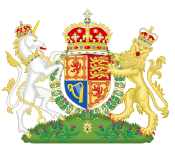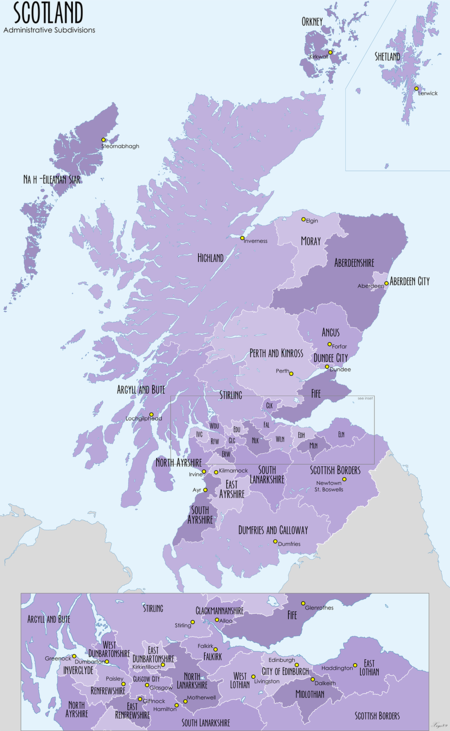- Subdivisions of Scotland
-
Scotland 
This article is part of the series:
Politics and government of
Scotland- Supreme Court of the United Kingdom
- Supreme Courts
- Sheriff Courts
- Land Courts
- Justice of the Peace Courts
- Lord Lyon Court
Her Majesty's Government
Parliament of the United Kingdom
- Scotland Office
- Grand Committee
- Select Committee
- Reserved matters
- Elections
- Constituencies
- List of Scottish MPs
Local government- Subdivisions of Scotland
- Convention of Scottish Local Authorities
For local government purposes, Scotland is divided into 32 areas designated as "council areas" which are all governed by unitary authorities[1] designated as "councils". They have the option under the Local Government (Gaelic Names) (Scotland) Act 1997[2] of being known (but not re-designated) as a "comhairle" when opting for a Gaelic name; only Na h-Eileanan Siar has chosen this option whereas the Highland Council (Comhairle na Gaidhealtachd) has adopted its Gaelic form alongside its English equivalent informally.
The council areas have been in existence since 1 April 1996, under the provisions of the Local Government etc. (Scotland) Act 1994.
Other administrative bodies (some of which are described below) still follow boundaries derived from older local government arrangements.
Contents
History of the subdivisions of Scotland
From 16 May 1975 to 1996 the local government divisions of Scotland consisted of an upper tier of regions each containing a lower tier of districts except for the single-tier island council areas.
Before then there existed counties, counties of cities, large burghs and small burghs, these being introduced since 1889. Before 1889 administration was on a burgh and parish basis.
Traditionally burghs have been the key unit of the local government of Scotland, being highly autonomous entities, with rights to representation in the old Parliament of Scotland. Even after the Acts of Union 1707, burghs continued to be the principal subdivision.
Council areas
MAINLAND Area
(sq miles)Area
(km²)Population
(2001)Density
(per km²)Aberdeen City 70 182 212,125 1164 Aberdeenshire 2439 6317 226,871 36 Angus 843 2184 108,400 50 Argyll and Bute 2712 7023 91,306 13 Clackmannanshire 61 158 48,077 304 Dumfries and Galloway 2489 6446 147,765 23 Dundee City 21 55 145,663 2648 East Ayrshire 492 1275 120,235 94 East Dunbartonshire 68 176 108,243 617 East Lothian 257 666 90,088 135 East Renfrewshire 65 168 89,311 532 City of Edinburgh 100 260 448,624 1725 Falkirk 113 293 145,191 496 Fife 517 1340 349,429 261 Glasgow City 68 175 577,869 3307 Highland 10,085 26,119 208,914 8 Inverclyde 64 167 84,203 503 Midlothian 135 350 80,941 231 Moray 864 2237 86,940 39 North Ayrshire 343 888 135,817 153 North Lanarkshire 184 476 321,067 674 Perth and Kinross 2083 5395 134,949 25 Renfrewshire 102 263 172,867 659 Scottish Borders 1825 4727 106,764 23 South Ayrshire 475 1230 112,097 93 South Lanarkshire 686 1778 302,216 170 Stirling 866 2243 86,212 38 West Dunbartonshire 68 176 93,378 531 West Lothian 165 427 158,714 372 TOTAL MAINLAND 28,260 73,193 4,994,276 68 ISLANDS Na h-Eileanan Siar 1185 3070 26,502 9 Orkney Islands 396 1025 19,245 19 Shetland Islands 568 1471 21,988 15 TOTAL ISLANDS 2149 5566 67,735 12 TOTAL SCOTLAND 30,409 78,759 5,062,011 64 Other subdivisions
Scotland has several other administrative divisions, some of which are handled by joint boards of the councils.
Police and fire services
Police and fire service areas date from the era (1975 to 1996) of regions and districts and island council areas. In both cases there are current (2011) intentions announced by the Scottish Government to reduce the overall number of separate services.
Electoral and valuation
There are several joint boards for electoral registration and the purposes of property valuation for assessing council tax and rates.[3]
Joint board area Council areas Ayrshire
Ayrshire and Arran in other contextsEast Ayrshire, North Ayrshire, South Ayrshire Borders Scottish Borders Central Scotland Clackmannanshire, Falkirk, Stirling Dumfries and Galloway Dumfries and Galloway Dunbartonshire and Argyll & Bute East Dunbartonshire, West Dunbartonshire, Argyll and Bute Fife Fife Grampian Aberdeen, Aberdeenshire, Moray Glasgow Glasgow Highlands and Western Isles Highland and Na h-Eileanan Siar (Western Isles) Lanarkshire North Lanarkshire, South Lanarkshire Lothian East Lothian, Edinburgh, Midlothian, West Lothian Orkney and Shetland Orkney Islands and Shetland Islands Renfrewshire East Renfrewshire, Inverclyde, Renfrewshire Tayside Angus, Dundee, Perth and Kinross Health
See also NHS Scotland
Health board area Council areas Ayrshire and Arran East Ayrshire, North Ayrshire and South Ayrshire Borders Scottish Borders Dumfries and Galloway Dumfries and Galloway Fife Fife Forth Valley
Central Scotland
in other contextsClackmannanshire, Falkirk and Stirling Grampian Aberdeenshire, City of Aberdeen and Moray Greater Glasgow and Clyde City of Glasgow, East Dunbartonshire, East Renfrewshire,
Inverclyde, Renfrewshire and West Dunbartonshire, together with
the towns of Cambuslang and Rutherglen in South LanarkshireHighland Argyll and Bute and Highland Lanarkshire North Lanarkshire and South Lanarkshire (excepting the towns of
Cambuslang and Rutherglen which are in the Greater Glasgow and
Clyde health board area)Lothian City of Edinburgh, East Lothian, Midlothian and West Lothian Orkney Orkney Islands Shetland Shetland Islands Tayside Angus, City of Dundee and Perth and Kinross Western Isles (Eileanan Siar) Western Isles (Na h-Eileanan Siar) Transport
The Scottish Government has created seven "Regional Transport Partnerships", for establishing transport policy in the regions. They broadly follow council area groupings.
RTP area Council areas NESTRANS Aberdeen, Aberdeenshire TACTRAN Angus, Dundee, Perth and Kinross, Stirling HITRANS Argyll and Bute (except Helensburgh and Lomond), Highland, Moray, Western Isles, Orkney Shetland Shetland SEStran Edinburgh, Clackmannanshire, East Lothian, Falkirk, Midlothian, Fife, Scottish Borders, West Lothian SWESTRANS Dumfries and Galloway Strathclyde Partnership for Transport Argyll and Bute (Helensburgh and Lomond only), West Dunbartonshire, East Dunbartonshire, North Lanarkshire, South Lanarkshire, Glasgow, East Renfrewshire, Renfrewshire, Inverclyde, South Ayrshire, East Ayrshire, North Ayrshire Land Registration
The current land registration system in Scotland divides Scotland into 33 counties[4], each coming into effect on various dates between 1981 and 2003. These areas in most cases resemble those of the pre-1975 administrative counties with Glasgow being the only current city to form a registration county.
Sheriffdoms
Sheriffdoms are judicial areas. Since 1 January 1975 these have been six in number:[5]
- Glasgow and Strathkelvin
- Grampian, Highland and Islands
- Lothian and Borders
- North Strathclyde
- South Strathclyde, Dumfries and Galloway
- Tayside, Central and Fife
Civil parishes
Scotland is divided into 871 civil parishes which often resemble same-named but legally different ecclesiastical parishes. Although they have had no administrative function since 1930, they still exist and are still used for statistical purposes such as the census. Many former civil parish areas also continue to form current registration districts. It should be noted that many boundary changes have occurred over the years and that an area currently derived from an old parish might no longer contain a place previously within that parish. Similarly, county boundaries (as still used for land registration) have also changed over the years such that a parish mentioned historically (generally before the 1860s) as being in one county (or sometimes two due to straddling a border) might now be in a neighbouring county and consequentially in a different succeeding council area.
Communities
The base level of sub-division in Scotland is that of communities which may elect community councils (CCs). The main role of the CCs is to channel local opinion to larger local-government bodies. Otherwise they have very limited powers. There are around 1,200 communities in Scotland. Not all communities have councils; some have joint councils.
Scottish communities are the nearest equivalent to civil parishes in England.
See also
- List of articles about local government in the United Kingdom
- ISO 3166-2:GB, subdivision codes for the United Kingdom
- Fire and Rescue Authority (Scotland), a body responsible for fire services which is formed from persons representing the authority or authorities within its area.
References
- ^ With respect to Scotland the phrase "unitary authority" is merely descriptive; in the United Kingdom the phrase "unitary authority" as a designation is specific to local government areas in England.
- ^ Local Government (Gaelic Names) (Scotland) Act 1997
- ^ Scottish Assessors Association
- ^ Registers of Scotland publication - Land Register Counties and Operational Dates
- ^ The Sheriffdoms Reorganisation Order 1974 S.I. 1974/2087 (S.191)
Subdivisions of Scotland Local government regions · Historic counties · Burghs · Lieutenancy areas · Council areas · Parliamentary regions Scotland topics
Scotland topicsHistory Geography Geology · Climate · Demographics · Mountains and hills · Islands · Lochs · Waterfalls · Fauna · Flora · Highlands · Lowlands · Central Belt · Anglo-Scottish borderEconomy Companies · Bank of Scotland · Royal Bank of Scotland · North Sea oil · Whisky · Tourism · Harris Tweed · Renewable energy · Transport · Saltire FoundationLaw People Politics Religion Languages Culture Clans · Cuisine · Education · Flags · Coat of arms · Anthem · Hogmanay · Innovations · Literature · Music · Sport · World Heritage Sites · National identity · National symbols · Scottish surnames Category ·
Category ·  Portal ·
Portal ·  WikiProject
WikiProject Administrative geography of the United Kingdom
Administrative geography of the United KingdomUnited Kingdom • Local government • History England • Local government • History Subdivisions: Regions • Ceremonial counties • Metropolitan and non-metropolitan counties • Unitary authorities • Districts (list) • Civil parishes (list)Northern Ireland • Local government • History Scotland • Local government • History Wales • Local government • History Categories:
Wikimedia Foundation. 2010.

